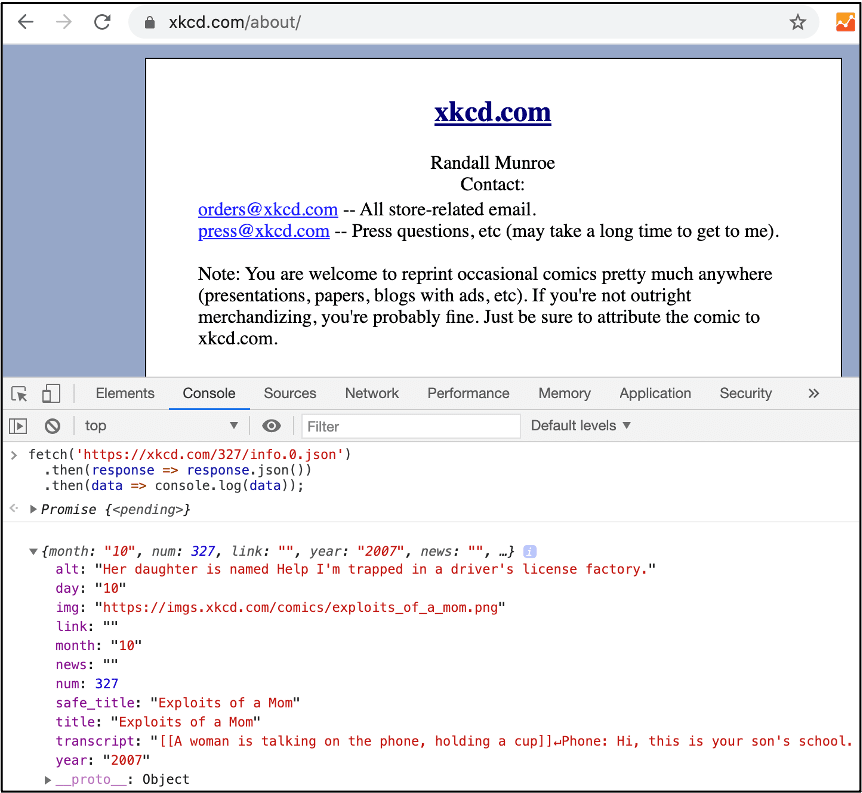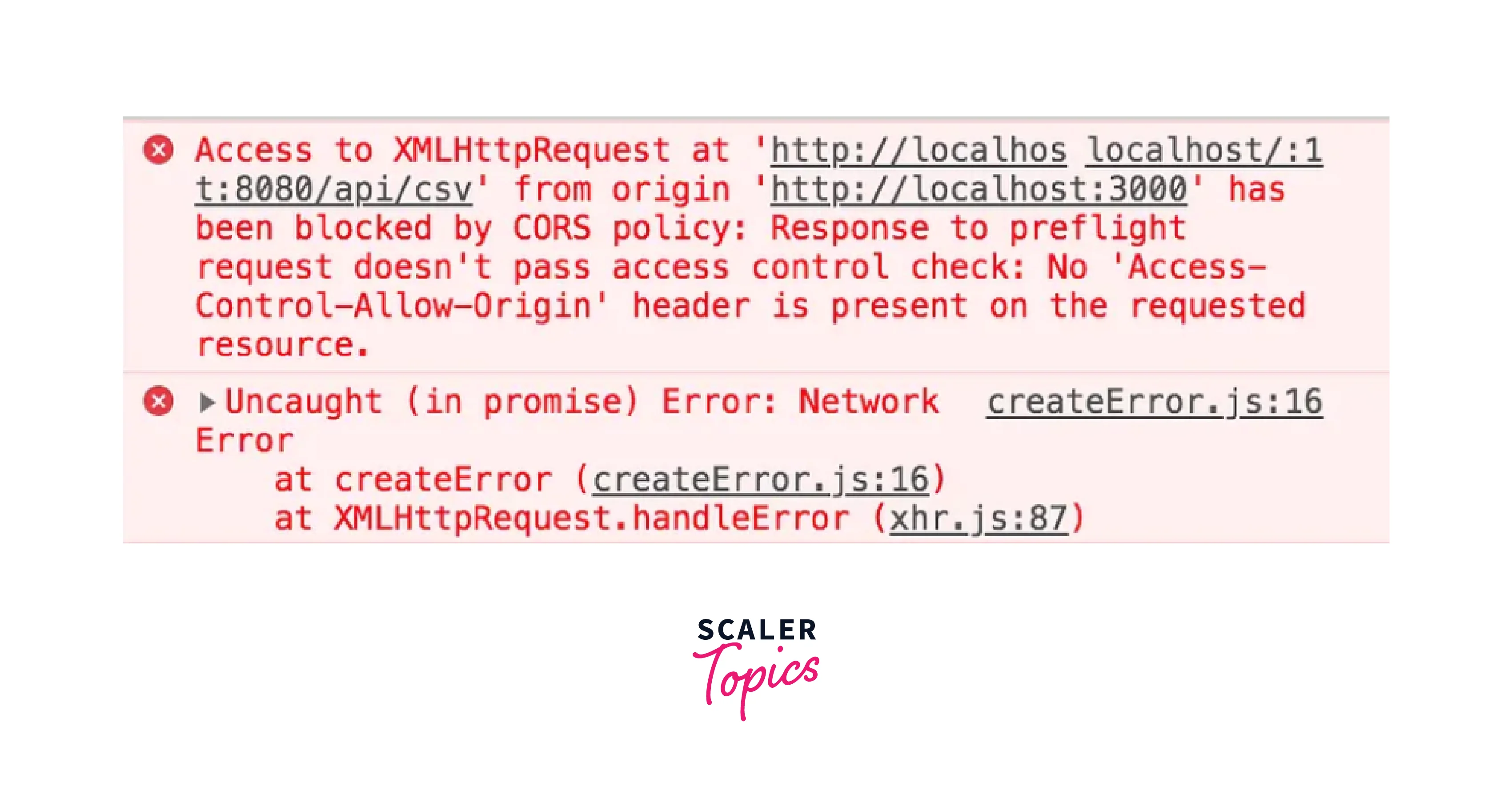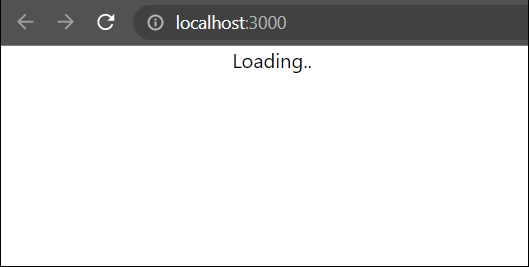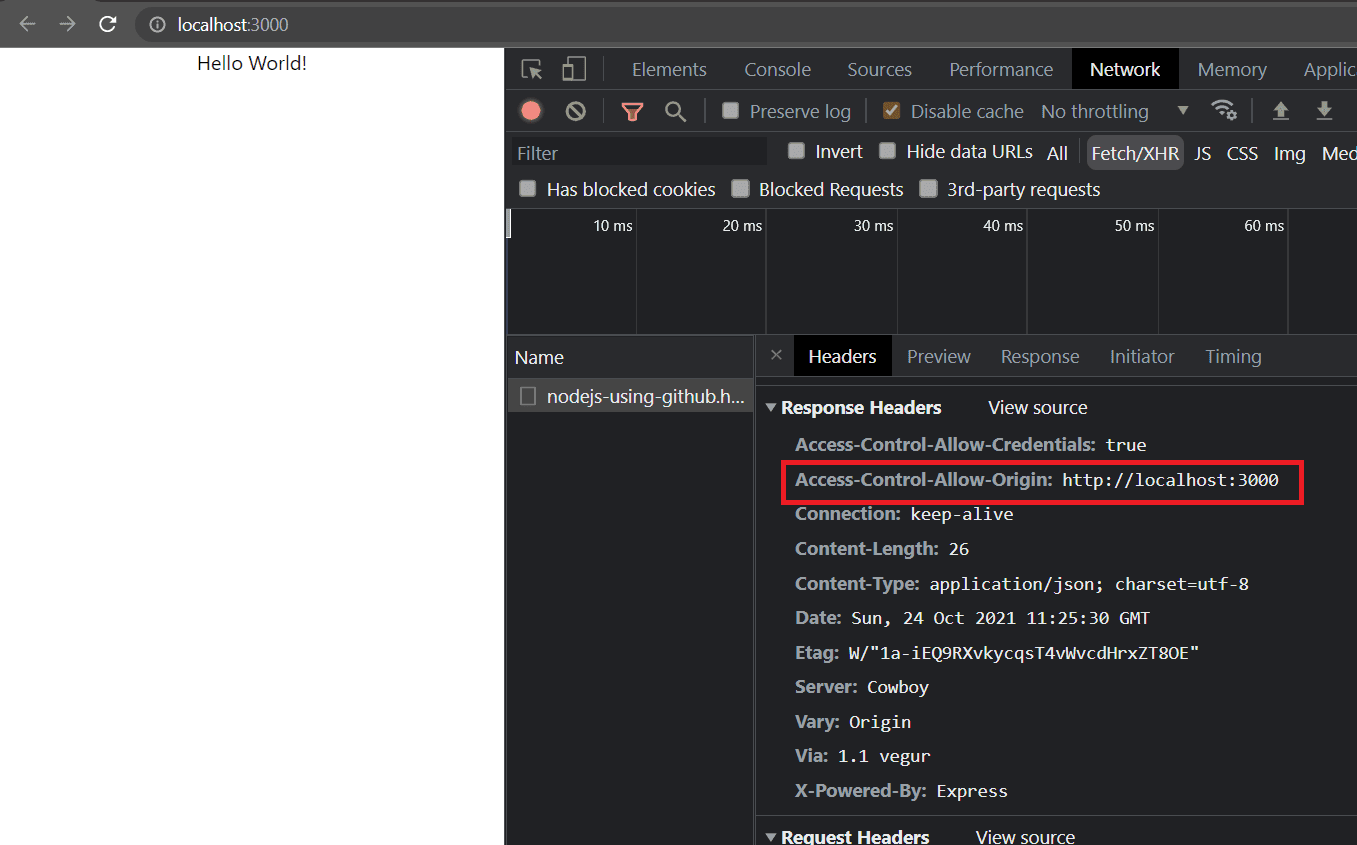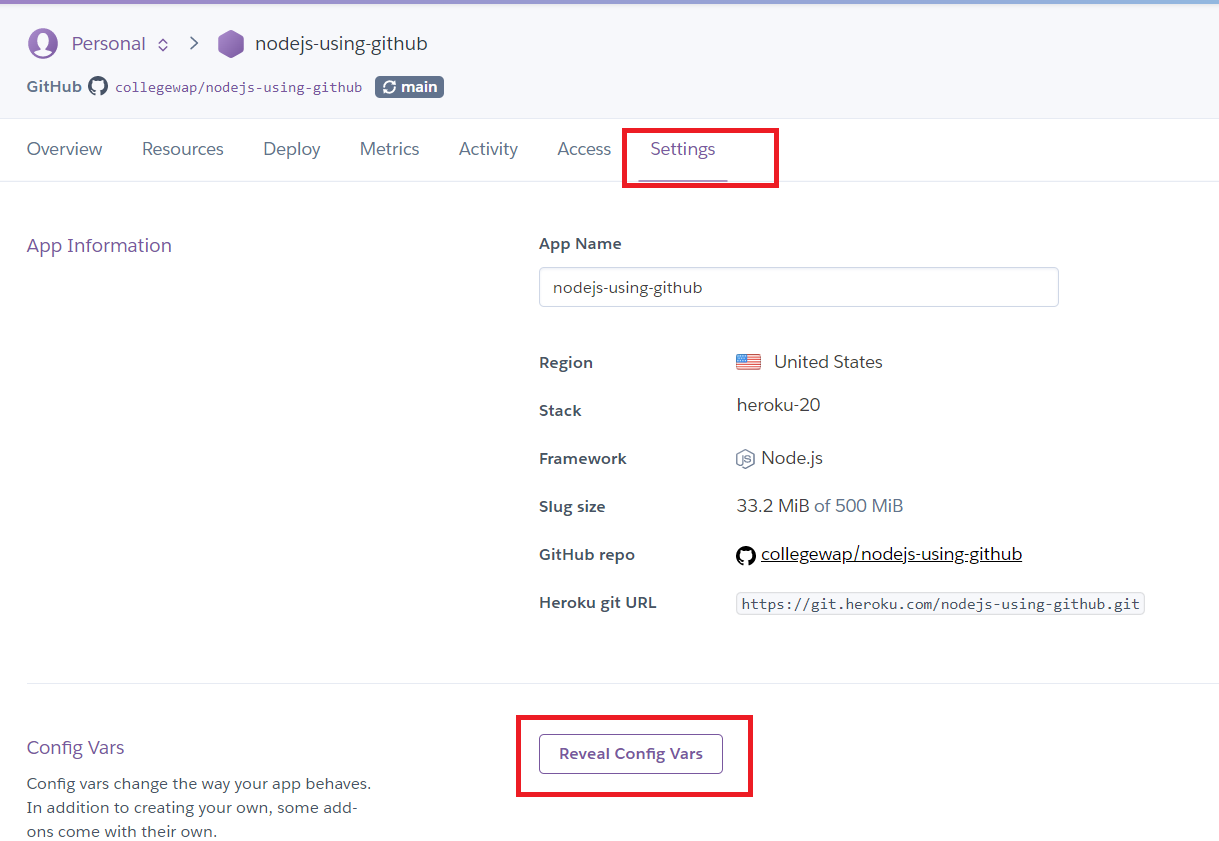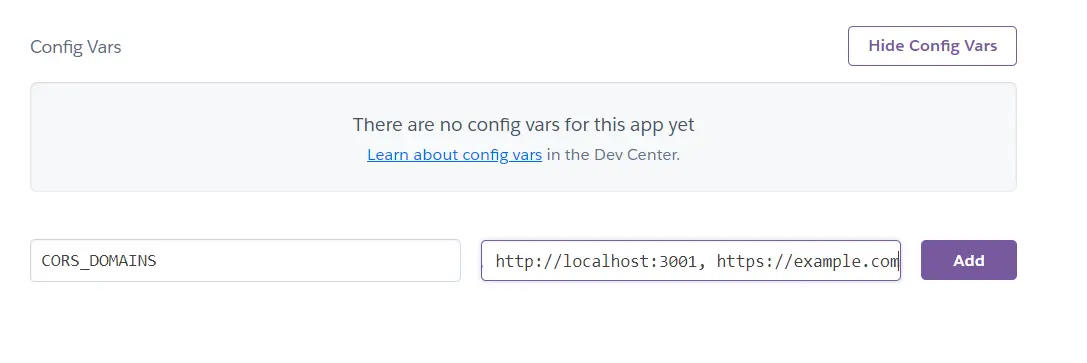I am trying to make an API call through Axios in my React Application. However, I am getting this CORS issue on my browser. I am wondering if i can resolve this issue from a client side as i dont have any access to the API internally. Attached is my code.
const response = axios({
method: "post",
dataType: "jsonp",
url: "https://awww.api.com",
data: {
appToken: "",
request: {
applicationName: "ddfdf",
userName: "jaime@dfd.com",
password: "dfd",
seasonIds: [1521ddfdfd5da02],
},
},
});
return {
type: SHARE_REVIEW,
payload: "response",
};
Attached is my WebPack.config.js
module.exports = {
entry: ["./src/index.js"],
output: {
path: __dirname,
publicPath: "/",
filename: "bundle.js",
},
module: {
loaders: [
{
exclude: /node_modules/,
loader: "babel",
query: {
presets: ["react", "es2015", "stage-1"],
},
},
{ test: /.json$/, loader: "json-loader" },
],
},
resolve: {
extensions: ["", ".js", ".jsx"],
},
devServer: {
historyApiFallback: true,
contentBase: "./",
},
node: {
dns: "mock",
net: "mock",
},
};
In Part 2 of this series, we’ll be making a REST API call from our React project to a service that has some CORS policies implemented. In this particular example, we’ll make REST API calls to xkcd’s API.
Make REST API calls to xkcd
What is xkcd?
xkcd is a webcomic series created by American author Randall Munroe. You can find the awesome comics here.
xkcd has an API?
Yes, it does indeed have an API.
You can find the great and concise API docs here.
What are we going to do?
We’ll make REST API calls to one of my favorite comic strips that has an ID of 327, i.e. our endpoint will be https://xkcd.com/327/info.0.json. This will return JSON data about that particular comic strip.
Let’s try calling it!
OK, so the implementation should be fairly simple. We made our REST API call to the Random User Generator API in our previous article — we just have to switch around the endpoint URL, right?
//const restEndpoint = "https://randomuser.me/api/";
const restEndpoint = "https://xkcd.com/327/info.0.json";
Enter fullscreen mode
Exit fullscreen mode
OK that was super easy! Now let’s refresh our React page.
…? Access to fetch at blah blah from origin bleh bleh has been blocked by CORS policy …. say what now???
Well, it looks like the response didn’t render. And there seems to be a whole lot of red text in the console…_(┐「ε:)_
That error we see in the console is well known as the CORS Error. Basically, resources that lie on xkcd’s domain cannot be requested from another domain (i.e. our front-end React App).
There are several ways we can overcome this issue:
- Make REST API calls from the same domain as xkcd
- Edit the CORS settings of xkcd’s server
- Make REST API calls from our own backend server
We can quickly experience method 1 if we navigate to any page on xkcd, and run the following code in the console.
fetch('https://xkcd.com/327/info.0.json')
.then(response => response.json())
.then(data => console.log(data));
Enter fullscreen mode
Exit fullscreen mode
The REST API request is being made on the same domain, so we don’t run into any CORS errors. But it’s highly unlikely that xkcd will host our React App on their site for us, so this isn’t a realistic approach.
Method 2 again is unrealistic, since we don’t have permission to access the settings of xkcd’s server ¯(ツ)/¯
Method 3 is achievable by either setting up your own server and making requests from it, or using a services such as Zapier or Power Automate to make the requests for us.
In this article, we’ll proceed with Method 3 by setting up a backend server using Express, which will act as a proxy to make REST API calls to xkcd.
Set up Express
What is Express?
Express is a back-end web application framework for Node.
How will we use Express?
In this article, we’ll treat Express as a tool for creating custom endpoints that our front-end React App can make calls to. When we make requests to these custom endpoints, the Express server will make REST API calls to our desired 3rd party service endpoint, receive the response, and then route the response back to our React App.
If that was a bit hard to grasp, think of it like ordering food at a nice restaurant. If we (front-end App) go directly to the kitchen and order food directly to the chef (3rd party service), we’ll be scolded for bad manners (CORS errors). What we need to do is order food to the server (Express App). The server (Express App) will take our order, walk to the kitchen, and request for the food to the chef (3rd party service). After some time, the chef (3rd party service) will respond by giving the server (Express App) back a plate of food. The server (Express App) then carries the plate back to the table so that we (front-end App) can consume it.
Set up Express
OK, so let’s go ahead to set up Express. This is basically a new node project with the Express dependencies installed. We’ll want this project to be in a separate location from our React App, so let’s navigate back up to our myproject directory, create a new directory called backend, and navigate into it. Since the terminal we were using is running the React app, go ahead to use the commands in a new terminal window.
mkdir backend
cd backend
Enter fullscreen mode
Exit fullscreen mode
From here we’ll follow the Express installation tutorial to make our Express project.
npm init
Enter fullscreen mode
Exit fullscreen mode
You’ll be asked a number of questions but you can skip through them by hitting enter until it’s finished.
Continue to install some dependencies.
npm install express node-fetch cors
Enter fullscreen mode
Exit fullscreen mode
Finally, create a JavaScript file to work on — we’ll call ours server.js.
touch server.js
Enter fullscreen mode
Exit fullscreen mode
Set up the Express code
We’ll use this code for server.js
const express = require('express');
const cors = require('cors');
const fetch = require('node-fetch');
const PORT = 5000;
const app = express();
app.use(cors());
const corsOptions = {
origin: "http://localhost:3000"
};
const requestEndpoint = "https://xkcd.com/327/info.0.json";
// This function runs if the http://localhost:5000/getData endpoint
// is requested with a GET request
app.get('/getData', cors(corsOptions), async (req, res) => {
const fetchOptions = {
method: 'GET'
}
const response = await fetch(requestEndpoint, fetchOptions);
const jsonResponse = await response.json();
res.json(jsonResponse);
});
app.listen(PORT, () => {
console.log(`Example app listening at http://localhost:${PORT}`);
});
Enter fullscreen mode
Exit fullscreen mode
So, let’s go through the code.
We first set our port to 5000, as we need it to be separate from the port we use on our front-end React App, which was defaulted to port 3000.
const PORT = 5000;
Enter fullscreen mode
Exit fullscreen mode
Express commonly uses routing that defines how the server’s endpoints will respond to our front-end React App’s requests. In this case, we’ve defined how the server will react when the endpoint http://localhost:5000/getData is accessed with a GET request.
app.get('/getData', cors(corsOptions), async (req, res) => {
//...
});
Enter fullscreen mode
Exit fullscreen mode
But by default, our Express server will return CORS errors if accessed from our front-end React App that lies on a different domain (port). By setting up some CORS options, we allow requests from port 3000 to access our resources that lie on http://localhost:5000/getData.
app.use(cors());
const corsOptions = {
origin: "http://localhost:3000"
};
app.get('/getData', cors(corsOptions), async (req, res) => {
//...
});
Enter fullscreen mode
Exit fullscreen mode
If we were to access http://localhost:5000/getData with a GET request from our React App, Express will run the related function, which in this case would be a fetch request to the xkcd REST API endpoint. As this request is made from the server side, it does not run in to any CORS errors. The response from xkcd is obtained, and returned back to our React App through the res.json() method.
const fetchOptions = {
method: 'GET'
}
const response = await fetch(requestEndpoint, fetchOptions);
const jsonResponse = await response.json();
res.json(jsonResponse);
Enter fullscreen mode
Exit fullscreen mode
OK, now that’s ready, let’s start running the express server!
node server.js
Enter fullscreen mode
Exit fullscreen mode
We can quickly see if it’s running successfully by accessing http://localhost:5000/getData through the browser. We should see the JSON response being displayed.
OK, so it looks like the Express App is making successful REST API calls to https://xkcd.com/327/info.0.json. Note that if we want to make any changes to server.js, we should restart the App to see the changes take place.
Let’s leave the Express server running, and return back to our React code so that it points to the Express App rather than directly to the xkcd server.
Update the React code
There isn’t much to do here, except for updating our REST endpoint to our Express server instead of the xkcd endpoint.
// const restEndpoint = "https://xkcd.com/327/info.0.json";
const restEndpoint = "http://localhost:5000/getData";
Enter fullscreen mode
Exit fullscreen mode
Refresh the browser, and let’s see if we’ve managed to bypass the CORS error.
Great! The REST API response has successfully rendered onto our HTML, and there are no CORS errors in our console.
And with that, we’ve managed to successfully avoid CORS errors to make REST API calls to xkcd by using our Express server as a proxy!
Next steps
In the next part of the series, we’ll make a REST API call to a Web Database service, Kintone, which will challenge us to our next issue.
_人人人人人人人人人_
> AUTHENTICATION <
 ̄Y^Y^Y^Y^Y^Y^Y^Y ̄
(__/)
(•ㅅ•)
/つ つ
Enter fullscreen mode
Exit fullscreen mode
If you’ve written any frontend code, you’ve likely encountered a CORS error before, like this:
Access to _ has been blocked by CORS policy
Cross-Origin Resource Sharing (CORS) is a protocol that defines how web requests should be handled when they are across different URLs.
Why are cross origin requests an issue?
Your browser holds a lot of state about you for every website you visit. Let’s say you are logged in to mybank.com and you have a cookie set with mybank.com indicating that you are logged in.
While you are browsing, you accidentally visit malicious.site, which makes a request to mybank.com that looks like this:
// Fetch request made from https://malicious.site
fetch("https://api.mybank.com/account_details", {
method: "GET",
credentials: "include",
})If this request was allowed and your cookie was included, the owner of malicious.site would be able to make requests on your behalf and read your account details.
With CORS, the server is allowed to specify which cross-origin requests it will accept vs reject. It can reject requests that need cookies. It can reject requests from untrusted.mybank.com but accept requests from app.mybank.com. It can reject all POST requests but allow GETs and PUTs.
The important thing to note about CORS is that the configuration/settings are done on the server and enforced by both the server and your browser. Most server frameworks have a library for configuring your CORS headers, but if you want to see the underlying headers themselves, here’s a good resource.
Practical example
Let’s say we have a React application with an Express backend. Our frontend is running on port 3000 — a common default for React.
Since our backend cannot also run on port 3000 locally, we’ll setup Express to run on port 4000.
const express = require('express')
const app = express()
const port = 4000
app.get('/whoami', (req, res) => {
res.send('Who is anybody?')
})
app.listen(port, () => {
console.log(`Example app listening on port ${port}`)
})If our React application made a fetch request to our backend like this:
// Fetch request made from http://127.0.0.1:3000
fetch("http://127.0.0.1:4000/whoami")we should expect a CORS error. Just like our earlier example, 127.0.0.1:3000 and 127.0.0.1:4000 are treated as two separate domains, so you cannot make requests across them yet. Let’s look at a few ways to fix this.
Fix 1: Fixing the server
One approach is to fix our server. We can do this by installing a CORS library (https://www.npmjs.com/package/cors) and telling the server to expect requests from 127.0.0.1:3000
app.use(cors({
origin: 'http://127.0.0.1:3000',
}))Our requests will now succeed. This approach is pretty straightforward and is generally good practice. We can use this same approach in production in case our frontend and backend are hosted on two different subdomains.
Fix 2: Adding a proxy
In production, in some cases, you’ll host your frontend and backend from the same origin. In these cases, you usually want to write fetch code that looks like this:
fetch("/whoami")instead of like this:
const url;
if (process.env.NODE_ENV === "production") {
url = "https://www.example.com/whoami"
} else {
url = "http://127.0.0.1:4000/whoami"
}
fetch(url)To do this, create-react-app actually comes natively with the ability to set up a simple proxy. Add the following to your package.json:
"proxy": "http://localhost:4000",Then, any request that looks like an API request (e.g. has a content type application/json) will automatically get forwarded to http://localhost:4000.
The reason this bypasses CORS issues is because, to the browser, the request is going to http://localhost:3000 and therefore doesn’t look like a cross-origin request. The server at http://localhost:3000 does forward the request to http://localhost:4000, but the browser doesn’t know that.
If you are using Next.js instead of create-react-app, you can set up a redirect in your next.config.js which will forward all matching traffic:
module.exports = {
async rewrites() {
return [
{
source: '/api/:path*',
destination: 'http://localhost:4000/:path*'
}
]
}
}Summary
The simplest way to fix any CORS issues in React and Next.js is actually not to change anything in React or Next.js but instead to fix your server to allow requests from them.
If you cannot change the server, both React and Next.js have ways for you to turn them into proxies and proxy requests to your backend on your behalf. This avoids any CORS issues by making your browser think the request is not a cross-origin request anymore.
Overview
Cross-Origin Resource Sharing (CORS) is a mechanism that allows client applications to request limited resources hosted on a server. These resources include web fonts, videos, scripts, iframes, images, and style sheets. By default, a client application making an AJAX request can only request resources that are on the same origin as the site on which the client application is running.
CORS stands for Cross-Origin Resource Sharing. When one domain requests a resource from another domain, it is called a cross-domain request. For security reasons, you may only want domains that can access server resources (other than our domain). This is where CORS comes in. CORS technology allows servers to specify resources to load from sources other than HTTP headers (domain, scheme, or port).
CORS Error in React
Cross-Origin Resource Sharing (CORS) is a protocol that allows scripts running in browser clients to interact with resources from different origins. This is useful because JavaScript can only call URLs that have the same origin as where the script is running, thanks to the same-origin policy followed by XMLHttpRequest and fetching. For example, if a JavaScript app needs to make an AJAX call to an API running on a different domain, the same origin policy will prevent it.
Solution for CORS Error in React
The first solution for CORS Error in React is that you can tell your React app to forward requests to your server using the proxy property in your package.json file.
This is a simple one-step process. Go to your app’s package.json file and add the following property:
After restarting the React dev server, we can see that all requests go to localhost:8080 instead of localhost:3000. Transferred the React development server to the backend server. The above works for third-party services as well.
Under the hood, when a React app requests a resource from localhost:8080, it pretends to request it from the origin localhost:8080 instead of localhost:3000. This seems to match the browser’s SOP and no longer causes CORS Error in React.
Let’s say you’re using a service at https://randomservice.com and you get a CORS error. You can add the URL inside the proxy property of your package.json file.
The development server tries to send the request to the proxy without text/html in the Accept header.
So for the above method to work, you need to make sure there is no text/html in the server’s Accept header. In rare cases, you may need to specify multiple proxy URLs. You can manually configure the proxy using the HTTP-proxy-middleware package by following the instructions here.
Another solution for CORS Error in React is to create a proxy middleware for creating this following these steps.
Add the add setupProxy.js file to the src directory and add the following code block.
Now, like in the previous step, all requests starting with /api from your react app will be intercepted by the middleware and served from http://localhost:8080/api.
Method to Setup CORS Request in React App at Front End Level
-
Axios:
Axios every time uses the Uniform Resource Locator(URL) to initiate the request, and the browser knows that the HTTP OPTIONS request is made to itself first. Often, a token needs to be passed for certification, and it is found by the bearer. The body must pass an additional CORS header. I need this because the browser needs to check with the server if it is allowed to access the resource. -
Fetch:
Use the mode option and set it to cors while fetching.
Create a New React App
Let’s create it with the following command:
After creating the project folder, switch with the following command.
For getting the API data, we used Axios. You have to install it by passing the command:
Demo of CORS options for ReactJS. Write down the following code
index.js:
App.js:
Now run the application by passing the following command on the terminal
Output:
Open your browser. It will by default open a tab with localhost running (localhost:3000).
Explanation:
You can see there are no CORS errors in the console. So you have successfully mastered CORS Error in React.
Conclusion
- CORS is a mechanism that allows certain domains to accept requests from other domains and share resources with each other.
- As we have seen, enabling CORS in the browser is very easy. This will open up many new possibilities that we can use more easily for both developers and users.
- The next time a CORS Error in React occurs, it needs to be handled server-side first. If you’re short on time, you can set up a proxy for your React app for development.
- CORS is primarily implemented in web browsers, but can optionally be used by API clients. It is present in all popular web browsers such as Google Chrome, Firefox, Opera, and Safari.
- I’ve tried to explain what CORS is and what are the most common problems with CORS Errors in React.
- In this article, you learned what CORS is and how it works in general.
Table of Contents
In the previous article, I have explained how to deploy a Node.js application to Heroku.
In this tutorial, we will be making use of the endpoint created there and see if we can use it in our React project.
Project Setup
Let’s create a React project using the following command:
1npx create-react-app react-cors
Now update the App.js with the following code:
App.js
1import { useEffect, useState } from "react"
2import "./App.css"
3
4function App() {
5 const [message, setMessage] = useState("")
6 useEffect(() => {
7 fetch("https://nodejs-using-github.herokuapp.com/")
8 .then(response => response.json())
9 .then(data => {
10 setMessage(data.message)
11 })
12 .catch(err => console.log(err))
13 }, [])
14 return <div className="App">{message ? message : "Loading.."}</div>
15}
16
17export default App
Here we have a local state called message, which we show to the user.
If the message is empty, then we display them with a loading text.
When the component is mounted (useEffect), we make a call to the API endpoint and fetch the message.
Now let’s run this and see if it works:
You will see that only «Loading..» text is displayed and the message never loads.
If we inspect the page and see the console, we will see the following error:
Access to fetch at 'https://nodejs-using-github.herokuapp.com/' from origin 'http://localhost:3000' has been blocked by CORS policy: No 'Access-Control-Allow-Origin' header is present on the requested resource. If an opaque response serves your needs, set the request's mode to 'no-cors' to fetch the resource with CORS disabled.
In the next sections, we will see what is CORS and how to fix this error.
What is CORS (Cross-Origin Resource Sharing)?
CORS stands for Cross-Origin Resource Sharing,
which is an HTTP header based mechanism that helps the server to tell the browser,
from which all domain requests can be made (except the same domain).
That is, in our case, the Node.js server hosted at https://nodejs-using-github.herokuapp.com/,
does not tell the browser that request can be made from http://localhost:3000.
When this happens, your browser will throw an error as seen earlier.
Why CORS (Cross-Origin Resource Sharing)?
The next question that would come to your mind is why do we really need this mechanism.
Imagine you are logged into your bank account or any social media website, then you visit a malicious website.
This malicious website could run some scripts in the background to make API calls to your banking or social media to get your personal details.
To prevent this, your browser checks if the request to the banking or social media server can be made from the malicious website and throws the CORS error.
So CORS exists to share certain resources between trusted third-parties (across different origins/domains), hence the name Cross-Origin Resource Sharing.
How to configure CORS in Node.js
Since we are clear about what and why is CORS required, let’s see how to enable CORS in the Node.js application.
You may clone the Node.js code from this repo.
Once the project is cloned, open it in your code editor and install cors package.
Now open index.js and update it with the following code:
index.js
1const express = require("express")
2const cors = require("cors")
3const app = express()
4const port = process.env.PORT || 3000
5
6const whitelist = ["http://localhost:3000"]
7const corsOptions = {
8 origin: function (origin, callback) {
9 if (!origin || whitelist.indexOf(origin) !== -1) {
10 callback(null, true)
11 } else {
12 callback(new Error("Not allowed by CORS"))
13 }
14 },
15 credentials: true,
16}
17app.use(cors(corsOptions))
18
19app.get("/", (req, res) => {
20 res.send({ message: "Hello World!" })
21})
22
23app.listen(port, () => {
24 console.log(`Example app listening at Port: ${port}`)
25})
Here we check if the origin (client’s domain) is in the whitelist, then we tell the clients that requests can be made.
If it is not in the list then we throw an error saying the client is not allowed to make CORS requests to this server.
The domain should not have any trailing slashes (/)
We can deploy the changes to Heroku and see if this works.
Now if you reload your page, you should be able to see the message.
You will also see that a response header called Access-Control-Allow-Origin has been added with the value http://localhost:3000.
Making CORS domains configurable
If you have multiple client origins to be connected to you, and you want them to be configurable, you can do so by using environment variables:
index.js
1const express = require("express")
2const cors = require("cors")
3const app = express()
4const port = process.env.PORT || 3000
5
6const domainsFromEnv = process.env.CORS_DOMAINS || ""
7
8const whitelist = domainsFromEnv.split(",").map(item => item.trim())
9
10const corsOptions = {
11 origin: function (origin, callback) {
12 if (!origin || whitelist.indexOf(origin) !== -1) {
13 callback(null, true)
14 } else {
15 callback(new Error("Not allowed by CORS"))
16 }
17 },
18 credentials: true,
19}
20app.use(cors(corsOptions))
21
22app.get("/", (req, res) => {
23 res.send({ message: "Hello World!" })
24})
25
26app.listen(port, () => {
27 console.log(`Example app listening at Port: ${port}`)
28})
Testing environment variables locally
To test environment variables locally, you can install the package called dotenv:
Now create a file called .env in the root directory of your project with the domains:
1CORS_DOMAINS = http://localhost:3000, http://localhost:3001, https://example.com
Update index.js to use the dotenv package:
index.js
1const express = require("express")
2const cors = require("cors")
3const app = express()
4const port = process.env.PORT || 3000
5
6if (process.env.NODE_ENV !== "production") {
7 require("dotenv").config()
8}
9
10const domainsFromEnv = process.env.CORS_DOMAINS || ""
11
12const whitelist = domainsFromEnv.split(",").map(item => item.trim())
13
14const corsOptions = {
15 origin: function (origin, callback) {
16 if (!origin || whitelist.indexOf(origin) !== -1) {
17 callback(null, true)
18 } else {
19 callback(new Error("Not allowed by CORS"))
20 }
21 },
22 credentials: true,
23}
24app.use(cors(corsOptions))
25
26app.get("/", (req, res) => {
27 res.send({ message: "Hello World!" })
28})
29
30app.listen(port, () => {
31 console.log(`Example app listening at Port: ${port}`)
32})
Here we made sure that .env files are loaded only in non-production environments.
It is recommended to store the configurations in the server host rather than in .env files for production.
Remember to add
.env*to the.gitignorefile so that you don’t accidentally push them to the repo.
Configuring environment files in heroku
With our latest code, we can configure environment files in the heroku settings:
Go to your project settings and click on «Reveal Config Vars». Now you can provide the key and values here and click on «Add»
Once added, you can push your changes and see if the changes work.
If you have liked article, stay in touch with me by following me on twitter.



